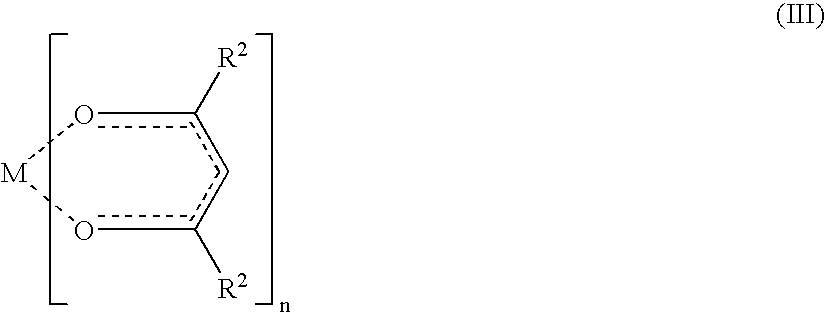Primer for heat-curable silicone elastomers
a technology of silicone elastomers and primer compositions, which is applied in the direction of film/foil adhesives, synthetic resin layered products, instruments, etc., can solve the problems of insufficient primer compositions and cohesion tearing in rubber, and achieve the effect of improving the adhesion of silicone rubber
- Summary
- Abstract
- Description
- Claims
- Application Information
AI Technical Summary
Benefits of technology
Problems solved by technology
Method used
Image
Examples
example 1
[0114] 10.5 g of partial hydrolysis product 1, 9.8 g of tetrabutyl titanate and 9.0 g silicone resin 1 are dissolved in 120 g of a hydrocarbon fraction having a boiling range of 110-140° C. and stirred for one hour at room temperature.
example c2
Not According to the Invention
[0115] 10.5 g of partial hydrolysis product 1 and 9.8 g of tetrabutyl titanate are dissolved in 125 g of a hydrocarbon fraction having a boiling range of 110-140° C. and stirred for one hour at room temperature.
example 3
[0116] 10.5 g of partial hydrolysis product 1, 9.8 g of tetrabutyl titanate, 9.0 g of silicone resin 1 and 4.5 g of vinyltriethoxysilane are dissolved in 115 g of a hydrocarbon fraction having a boiling range of from 110-140° C. and stirred for one hour at room temperature.
PUM
| Property | Measurement | Unit |
|---|---|---|
| Temperature | aaaaa | aaaaa |
| Temperature | aaaaa | aaaaa |
| Temperature | aaaaa | aaaaa |
Abstract
Description
Claims
Application Information
 Login to View More
Login to View More - R&D
- Intellectual Property
- Life Sciences
- Materials
- Tech Scout
- Unparalleled Data Quality
- Higher Quality Content
- 60% Fewer Hallucinations
Browse by: Latest US Patents, China's latest patents, Technical Efficacy Thesaurus, Application Domain, Technology Topic, Popular Technical Reports.
© 2025 PatSnap. All rights reserved.Legal|Privacy policy|Modern Slavery Act Transparency Statement|Sitemap|About US| Contact US: help@patsnap.com

